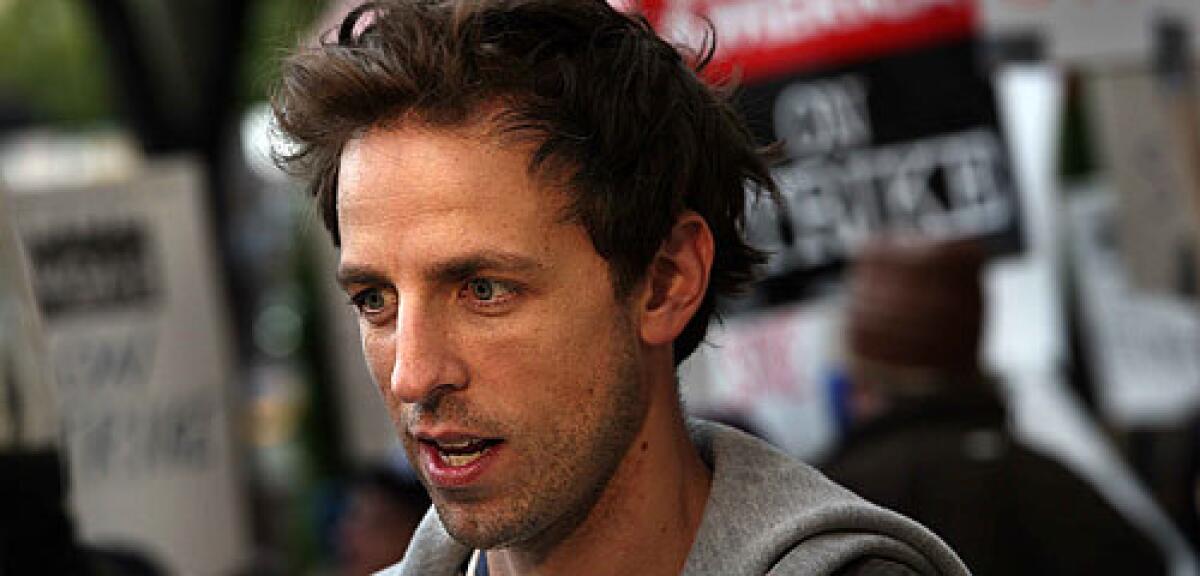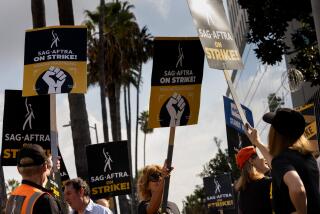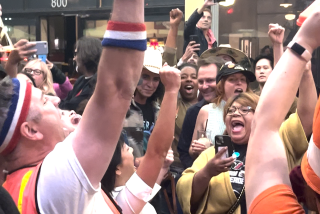Strike coverage was hazardous duty

IT’S official: The strike drove writers nuts.
No, not TV and film writers. Journalists.
Fourteen weeks of covering bitter trench warfare between the Writers Guild of America and the studios, and the ink-stained wretches are feeling wretched. It’s not just that covering a complex, polarizing news story for more than three months left them fried. The worst part has been the blowback. And we don’t mean from the studios and networks, either. No, friends, it’s the ugliest kind of warfare: writer on writer.
You recall Woody Allen’s joke about intellectuals: They’re like the mob. They only kill their own.
Consider that the strike hadn’t even started when outspoken guild members -- suddenly multiplying like accused Communists during the Red Scares -- began sharpening their pikes for the heads of Variety’s staff, whom they quickly condemned as the studio bosses’ bootlickers. Strange but, during normal times, scenarists’ biggest gripe against the trades is that they don’t run their photos big enough when splashing a script sale across the front page.
Nikki Finke, whose blog www.deadlinehollywooddaily.com functions as a kind of cross between Louella Parsons and Madame DeFarge, launched vituperative, near-daily attacks on strike news in competing outlets, including this newspaper, one of her former employers (last month, she told movie columnist Patrick Goldstein to “stop shilling” for the studios after he wrote a column she didn’t like).
And last week, the New York Press newspaper put New York Times reporter Michael Cieply (another former Los Angeles Times staffer) on the couch. Using his strike dispatches as evidence, the analysis found the patient suffering from a chronic case of Anti-Labor Disorder, brought about by his publicly unacknowledged need for the “industry respect” that “he so clearly craved.”
Gadzooks! What in the name of Cesar Chavez has prompted all this nuttiness? Does covering labor unrest in Hollywood today mean turning yourself into a virtual dartboard?
Survey says: Yes.
“It was a very emotional strike,” said Peter Bart, longtime editor in chief of Variety, who says he’s proud of his newspaper for objective reporting during the work stoppage. He added, “It seemed more emotional and more ideological than the last strike,” referring to the five-months-plus writers’ walkout in 1988.
As one entertainment-beat reporter, who declined to speak on the record because editors had not authorized the individual to do so, put it: “I went into a near-terminal depression when I realized there was going to be a strike.” Why? Because the reporter knew the level of vitriol that was in store.
Granted, there are probably very few collective-bargaining breakdowns in which calm reasoning is the order of the day. When people start arguing over money and livelihoods, there will be, you know, blood. That’s hardly specific to Hollywood. Furthermore, not many folks outside the profession can be moved to shed tears for journalists, who, along with attorneys, hedge-fund managers and Britney Spears’ handlers, are probably the least-liked people in America.
Yet there are some compelling reasons why covering this particular strike meant enjoying about as many lighthearted laughs as the doomed cave-dwelling Japanese soldiers in “Letters From Iwo Jima.”
Before the strike started, guild leaders took a confrontational stance toward the mainstream media (MSM), instructing members not even to speak with reporters from major news organizations. The principled rationale, as stated by officials, was that some of these news outlets were owned by the very conglomerates the writers were striking against. But many journalists viewed it as a familiar media-shutdown tactic: The guild was trying to choke off the flow of information, frame the story its own way and whip up membership fervor against another putative enemy. If you have a better way to make reporters and editors tear their hair out, file a patent now.
The guild was supposedly more friendly toward non-MSM bloggers, but even that posture was not absolute. Jonathan Handel, an entertainment attorney at the firm TroyGould who blogged about the strike for the Huffington Post, told me he got ample cooperation from NBC for an analysis of Jay Leno’s controversial decision to write his own monologues during the stoppage. But there was no response from the guild.
“And I used to work in the legal department of the Writers Guild!” Handel said. “I was disappointed and surprised by that.” (A guild spokesman did not reply to an e-mail seeking comment.)
The blogs are, in fact, the chief difference between ’88 and ’08. Blogs replicate, amplify and sometimes distort stories in ways that simply weren’t possible 20 years ago. And no blogger left a bigger footprint on strike coverage than Finke.
Initially regarded as a hero by many guild members -- she spared none of the hated grandees of the MSM, and her coverage of the union’s contract demands was unabashedly sympathetic, complete with exclusive pro-guild videos made by A-list celebrities -- Finke came to be viewed with suspicion. She made some doozies in the accuracy department (in late November, she quoted a “very reliable” unnamed source who said a strike settlement was “already done, basically”). She tried to graft a long stream of personal sickbed updates onto the larger drama of the strike (she rushed to let the world know when striking writers made up some jokes about her mucus).
So maybe it was inevitable that “Saturday Night Live” writer and performer Seth Meyers drew cheers during a guild awards skit when he told Rachel Dratch, who was impersonating Finke, that once the strike was over, “none of us are ever going to go to your website again.” (Finke did not reply to an e-mail seeking comment.)
Good laugh line, but blogs like Finke’s aren’t going away. In fact, Tom Rosenstiel, director of the Project for Excellence in Journalism, calls the blogs a “new tool in the arsenal of media manipulation,” a tool borrowed from the bare-knuckle world of political campaigning. And it’s no surprise that the blogs inflame debate during a strike, when the press “is a player [that] influences the participants,” he added.
Variety’s Bart is undecided about what all this media self-reference might mean. On the one hand, he finds it “onanistic” for writers to be writing more about one another than the subject at hand (re: this column: Touché). Yet he also thinks it can be healthy for established media outlets to be subjected to sometimes harsh outside critique.
His own influential column, “The Back Lot,” reflected plenty of ambivalence about the strike. Usually not a place to mince words, Bart’s columns seemed tentative and carefully phrased on the work stoppage. One was headlined “No One Wins When It Comes to Strike.” He told me he thought the paper should refrain from offering sweeping opinions about such an emotional, complicated issue.
But of course, where most journalists just talk about seeing both sides of a debate, Bart really does. His publication depends on advertising from the studio and network bosses. And Bart is also a member of the Writers Guild.
The Channel Island column runs every Monday. Contact Scott Collins at scott.collins @latimes.com
More to Read
The biggest entertainment stories
Get our big stories about Hollywood, film, television, music, arts, culture and more right in your inbox as soon as they publish.
You may occasionally receive promotional content from the Los Angeles Times.











